Napa Cabbage — Your New Best Veggie Friend
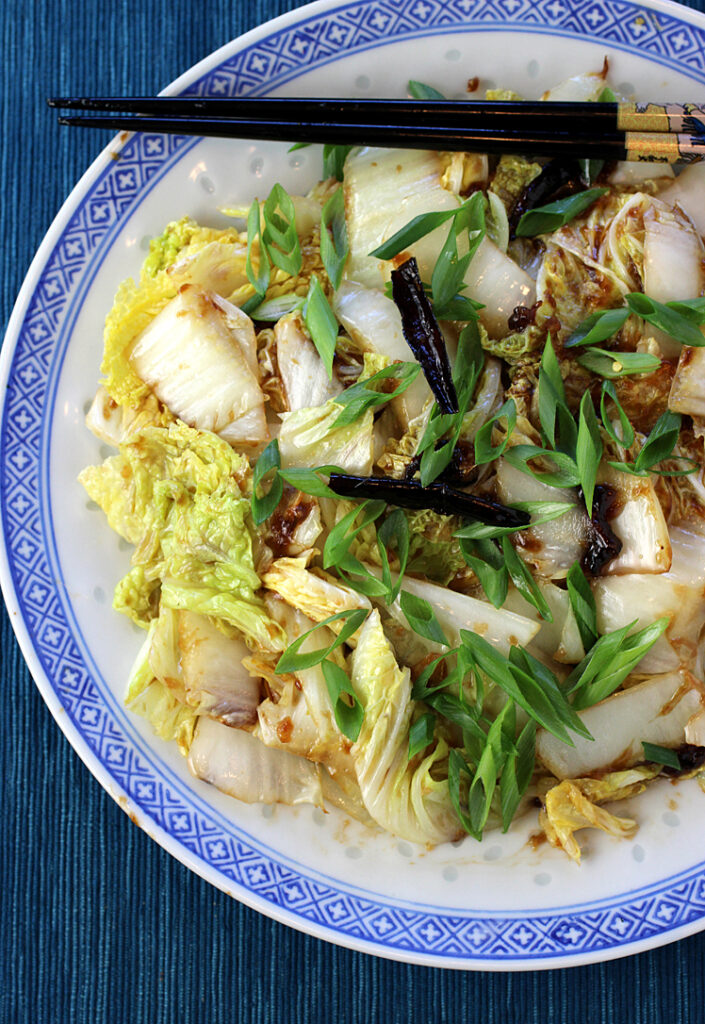
You want a best friend whom you can count on.
One who has lasting qualities.
One who rises to any occasion.
In short, in the world of vegetables, you want napa cabbage.
Crisp, sweet, slightly mustardy, super versatile, and able to last weeks in the fridge, it’s what you can loyally turn to time and time again.
I love it shredded raw in salads, roasted in the oven, steamed gently, and stir-fried as in this recipe for “Sour and Hot Napa Cabbage (Suan La Bai Cai).”
It’s a fast and easy side dish recipe that first appeared in the March/April 2023 issue of Cook’s Illustrated.
It’s based on a favorite dish from a local Sichuan restaurant that the staffers of the magazine frequented before it closed.
It gets its addictive, slightly sour taste from Chinese black vinegar that’s tangy, fruity, and savory. It pays to invest in a bottle from your local Asian market because it’s so handy for so many things, and keeps for a long time in the fridge. That being said, if you want to take the easy route, I learned a trick from the Bay Area’s Martin Yan, who often adds balsamic vinegar as a substitute for black vinegar in his cookbook recipes. It’s not exactly the same, but it will work in a pinch.
The “hot” part of the dish comes from dried peppers. As Cook’s Illustrated points out, Sichuan Facing Heaven chiles (available at Chinese markets) are the traditional ones used. However, the magazine notes that chiles de arbol can be substituted. That’s what I used, and they worked just fine.
The napa cabbage is sliced in a precise way: The leaves are separated, then stacked, with the white center portion cut out from each. The stalks are then sliced at a 45-degree angle to create greater surface area for which the sauce to cling. The green frilly part is then cut separately into 2-inch pieces.
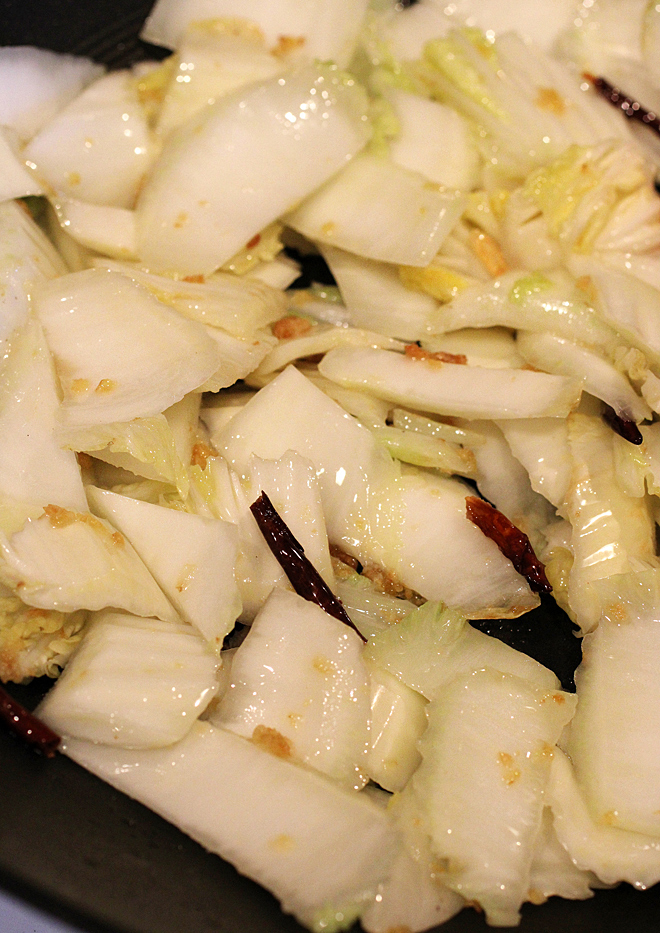
The stalks go into a hot wok first with the chiles, scallion whites, ginger, and garlic, because they take longer to cook. Then, the green leaves are added.
Whisk soy sauce, black vinegar, oyster sauce, sugar, and cornstarch together to form a slurry. The recipe calls for 1 tablespoon of cornstarch, which seemed like a lot for the small amount of liquid. It turned out to be too much, as the slurry seized up the moment I poured it into the hot wok to the point it was difficult to distribute it around all the cabbage.
The next time I make this, I will opt to use 1 teaspoon of cornstarch instead, which is what I changed it to in the recipe below. That should thicken up the mixture just enough, but still provide enough sauce to coat everything in the pan.
And there will definitely be a next time for this dish. It may be a humble one, but it packs a world of flavor. It’s tangy, savory, moderately spicy, and with a sweet, almost wine-y taste that plays off the crunchy yet tender cabbage.
Whenever you’re racking your brain for a simple yet satisfying vegetable dish to go with an Asian spread, look no further than this one.
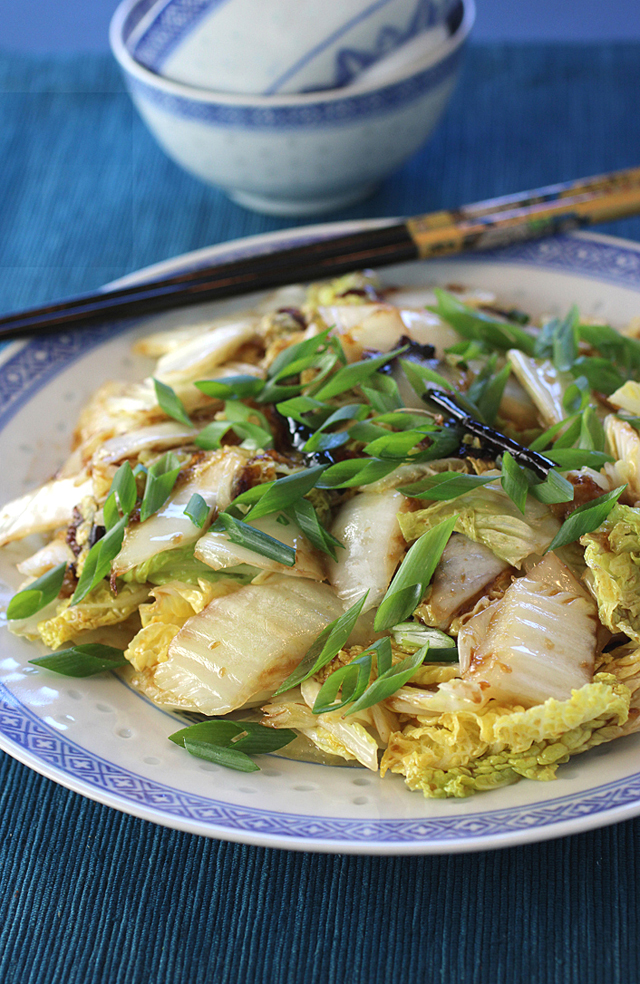
Sour and Hot Napa Cabbage (Suan La Bai Cai)
(Serves 4 to 6)
1 head napa cabbage (2 pounds)
2 tablespoons soy sauce
2 tablespoons Zhenjiang (also Chinkiang) black vinegar
1 tablespoon oyster sauce
1 teaspoon cornstarch
2 1/2 teaspoons sugar
2 tablespoons peanut or vegetable oil
3 to 5 small dried chiles (Sichuan Facing Heaven chiles or arbol), stemmed, halved, and seeded
1 scallion, white and green parts separated and sliced thin
1 tablespoon grated fresh ginger
1 tablespoon minced garlic
Discard any outer leaves from cabbage that are bruised or torn. Peel away enough leaves to yield 1 1/2 pounds (16 to 20 leaves). Reserve smaller leaves near core for another use. Stack three similar size leaves and, using sharp knife, remove white portion from center. Keeping pieces stacked, cut cabbage whites crosswise at 45-degree angle into 1-inch-thick slices and place in medium bowl. Cut cabbage greens into 2-inch pieces and place in second medium bowl. Repeat with remaining leaves.
Whisk soy sauce, vinegar, oyster sauce, cornstarch, and sugar together in a small bowl.
Heat oil in 14-inch wok (or12-inch nonstick or carbon-steel skillet) over medium heat until just smoking. Add chiles and cook, stirring constantly with wok spatula or wooden spoon, until they being to brown, about 30 seconds. Add scallion whites, ginger, and garlic, and cook, stirring constantly, until fragrant, about 1 minute.
Increase heat to high and add sliced cabbage white. Cook, stirring constantly, until cabbage begins to turn translucent at edges, about 2 minutes. Add chopped cabbage greens, and cook, stirring constantly, until greens begin to collapse and wilt, about 1 1/2 minutes longer.
Whisk soy sauce mixture to recombine and pour over cabbage. Cook, stirring constantly, until cabbage is evenly coated and sauce has thickened, about 30 seconds. Immediately transfer cabbage to large serving bowl. Garnish with scallion greens and serve.
Adapted from Cook’s Illustrated, March & April 2023 issue
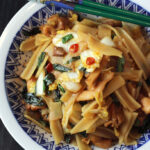
More Napa Cabbage Recipes to Enjoy: Drunken Noodles
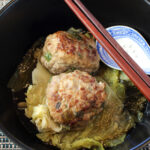

And: Featherweight Slaw

I’m all over this one, thanks!
Hi Reuel: Yay! I love how easy it is to make. Enjoy!
I have to admit that although I really like cabbage, I don’t cook it often enough. This sounds good.
Hi Karen: I became a believer in cabbage during the pandemic when we were all going grocery shopping less. It was such a godsend to have it in the fridge to use in so many ways, as well as for its long shelf life.
Pingback: Savor the Crunch: Napa Cabbage Recipes & Tips
I received Napa cabbage instead of lettuce in my online grocery order so turned it into this for lunch along with some breaded and fried tofu. It was yummy, thanks!
Hi Ashley: Yay! So glad you enjoyed the recipe, and that it made for a fine dish using that accidental cabbage. 😉